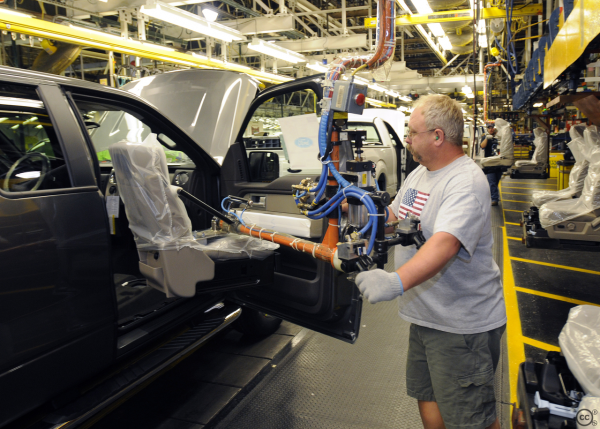As the climate crisis grinds on, policymakers and economic elites are finally reading the writing on the wall for fossil fuels. The major automobile manufacturing companies have been devastatingly slow on the uptake, but they’re now starting to signal a greater commitment to the transition to electric vehicles.
Over the summer, Ford announced plans to invest $3.7 billion in electric vehicle production facilities across the Midwest. General Motors has increased its electric vehicle production target from one million by 2025 to two million. Newer companies like Tesla, Rivian, and Lucid have made their mark by manufacturing electric vehicles and are set to continue to grow.
While electric vehicle production is not free from environmental problems, the use of these cars over gas-powered ones would certainly be better for the climate.
But without broader changes to our industrial policy, the transition to electric vehicle production will not necessarily be good news for workers in the automobile industry.
As a recent study by the Economic Policy Institute outlines, without increased domestic production of electric vehicle batteries and other power train components, the large-scale introduction of electric vehicles could result in the loss of over two hundred fifty thousand jobs in automobile assembly and parts production. Currently, 75 percent of power train components for gas-powered vehicles are manufactured in the United States, as compared to just under 45 percent for electric vehicles.
The assembly of battery-powered electric vehicles is less complex and requires fewer workers than vehicles with an internal combustion engine. These job losses can only be offset if two conditions are met: a significant strengthening of domestic industries in the electric vehicle supply chain and electric vehicles rising to 50 percent of domestic automobile sales by 2030.
The Economic Policy Institute modeled various scenarios for the large-scale introduction of electric vehicles in the US market. In a scenario where electric vehicles reach 30 percent of the market share with current domestic production levels of electric vehicle power train components, around twenty thousand assembly jobs and twenty-five thousand parts jobs would be lost.
However, if an increase in electric vehicle market share can be matched with corresponding levels of power train production, over a hundred fifty thousand jobs would be gained.
While these scenarios may seem like abstract and technocratic formulations, they have deep implications for the future of important segments of the working class. For those still employed in the production of automobiles, the industry represents a critical gateway to a higher standard of living.
Among autoworkers in the US, 74.6 percent do not have a college degree and most are concentrated in the states of the Upper Midwest and the South. Black workers have long been overrepresented in auto employment and today make up 16.6 percent of autoworkers (as compared to 12.5 percent of workers in the economy as a whole). Though greatly weakened relative to the past, the auto sector remains a base of unionization. Seventeen percent of autoworkers are under a collective bargaining agreement, while only 11.8 percent of the overall workforce is.
These workers will be a key component for those on the Left interested in rebuilding a working-class constituency through industrial policy. Fighting to make sure the transition to electric vehicles is done in a way that increases workers’ power and doesn’t result in job loss is of central importance.
But simply beefing up the electric vehicle domestic supply chain won’t automatically mean unionization. Further legislative action is needed that ties electric vehicle industry subsidies to strong labor standards, as well as deep labor law reform that makes it easier for workers to organize, like the PRO Act.
The labor movement itself needs to be ready for the fight ahead. Huge shifts currently taking place in the United Auto Workers could put the union in a better position to take on the challenge of organizing eclectic vehicle assembly and battery plants. In the recent leadership election, reformers from the Unite All Workers for Democracy (UAWD) caucus shocked many by winning five seats on the fourteen-member executive board. The seat for the presidency will be decided in a runoff.
After years of declining membership, concessionary contracts, and devastating corruption scandals, UAWD reformers have pledged to revive the union by activating its membership and taking on new organizing initiatives. The task of reigniting this once-mighty manufacturing union will be a decisive part of the broader fight for a pro-worker transition to electric vehicle production.
Initial signs indicate that the demand for a union is there. Earlier this month, nine-hundred workers at an electric vehicle battery plant in Warren, Ohio, voted resoundingly (710-16) to join the UAW. However, the union will need to be able to replicate these kinds of victories in the much more difficult terrain of the South, where many electric vehicle battery plants are moving.
In the current context of rampant economic inequality, US workers cannot afford the loss of more decent manufacturing jobs. While the shift to electric vehicles represents an opportunity for improvement on numerous environmental fronts, it also represents a potential catastrophe for the economic well-being of many working people.
Fortunately, we don’t have to choose between the two. Pairing the assembly of electric vehicles with a significant increase in production across the supply chain will lead to the creation of even more auto sector jobs than currently exists. Bold industrial policy and a rejuvenated United Auto Workers union can make electric vehicles a win for workers.
ZNetwork is funded solely through the generosity of its readers.
Donate

